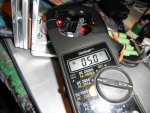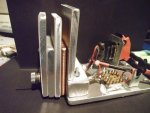- Joined
- Jul 10, 2015
- Messages
- 12,867
- Points
- 113
Thank you Alan, very helpful!
A few test results:
I bought the driver set @ 4500mA and it was already soldered to the diode when it arrived.
I was playing with the laser this afternoon and decide to add an ammeter (multimeter) between the driver and the diode.
Lab supply was set @ 8.0V and deliverd 2.4-2.5A (I set voltage, current is left unlimited.)
Surprisingly the multimeter reads 3.6xx mA to the laser diode.
I don't know why that is. I'm not acusing anyone, maybe I touched the potmeter with my fingers when handling it.
I soon realized that increasing temperature on the driver gives a higher amperage to the laser.
With a little screwdriver I set the driver @ 4.1xx mA (and I realized how sensitive that potmeter is)
Amperage quickly ramps up. After ~5 minutes the driver delivers 4.620mA and the 445gram module is 51degree Celsius (123.8 degrees Fahrenheit). Measured with IR-thermometer gun pointed close to a piece of black tape that I added to the heatsink. Room temperature is 26 degree Celsius (78.8 degrees Fahrenheit, yes its a nice summer)
Lab supply was of course still set @ 8.0V and delivered 3.0 Amps in the end
I disconnect power.
And reconnect after 1 minute with the heatsink still quite warm and driver having the same temperature as the heatsink now.
It takes 1-2 minutes for the driver to start from 4.1xx mA and ramp up to +46xx mA.
Kind of a heat-sensitive driver, right?
I hope it's not that little aluminium holder that is causing it.
I will make one out of plastic tonight.
Any thoughts?
I use an inductive amp meter, putting your meter in line will introduce resistance, using smaller wire will introduce resistance, and apparently getting even non ferrous metal near the inductor can affect these buck/boost type drivers.
I saw a difference in output when I first used solid core wire to attach the driver because the holes are smaller on these 4-6 amp drivers than the 2.4 amp drivers. You need to use heavy gauge wire such as the silicon wire that comes with it and keep both sides the same length and as short as possible.
My driver was set at 5 amps and I thought it was 4.5 until I balanced my wire and used the heavy gauge. My inductor is covered in aluminum but my driver works perfectly. My culprit was the wire. But I recommend going with the experts and not putting any metal near your inductor.
p.s. I have 2 of these NUBM44 diodes 1 in this test bed for working with optics that have yet to be delivered and the other in my finned flashlight, but I did check my other driver and it was set at 4.5, this one was set at 5.0 DTR is really good about doing a good job so it's probably your meter being in the circuit.
Attachments
Last edited:





